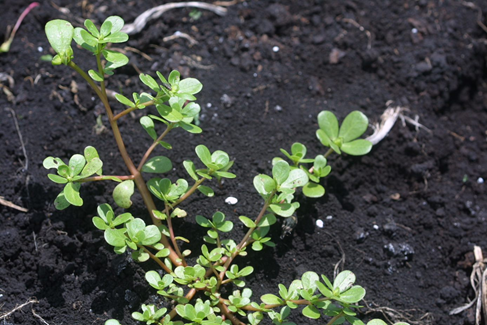Root is a thick taproot with fibrous roots.
Propagation is by seed and fragmented stem segments that root at the nodes

Portulacaceae (Purslane Family)
Group: Dicot (Broadleaf)
Annual prostrate herb with a mat forming habit with fleshy, thick and succulent stems, and leaves native of tropical or subtropical Asia. It is commonly found in cultivated fields, pastures, landscapes, lawns, and waste areas
Seedling cotyledon is linear, first true leaf is egg-shaped, with a narrow base and wide apex. Leaves are succulent, not petioled, and red tinged. Stems are prostrate and succulent.

Leaves of mature plants are alternate or nearly opposite, smooth, succulent, with untoothed margins, and usually purplish-red. Leaf is wedge-shaped (spatulate), broadly round at the tip, narrowing at the base, with no petiole.
Stems are prostrate, mat forming (12 inches or more in diameter), thick, succulent purplish red and root at nodes

Flowers are yellow, solitary in the leaf axils or clustered on the ends of stems. The fruit is a round capsule, which splits open around the middle to release the very small, black seeds.

Root is a thick taproot with fibrous roots.
Propagation is by seed and fragmented stem segments that root at the nodes